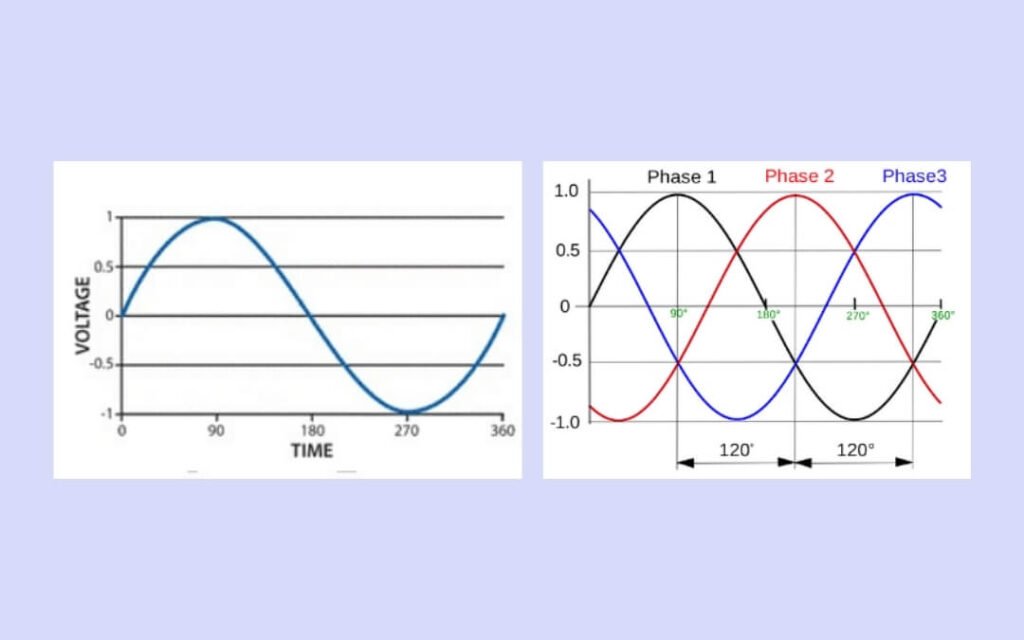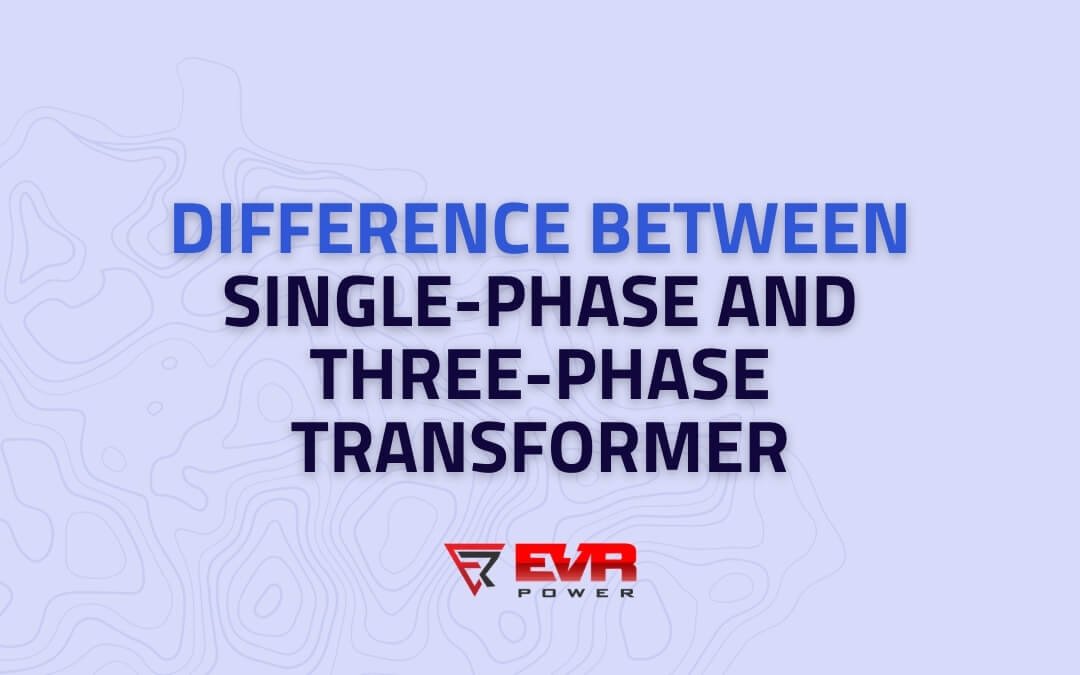Be it a trivial household appliance or the most magnificent and life-saving healthcare unit, high-quality transformers are necessary to keep operations running successfully.
A transformer is a fantastic device that converts the power voltage to required levels for a multitude of applications across utilities.
Various parameters/specifications make one transformer unique from the other. One such is the type of AC power supply i.e. Single-phase or Three-phase. It is significantly important to select the right transformer type that benefits you and provides you the best value for money.
That is why we have come up with this article to facilitate easy decision-making and help to choose between a single-phase transformer and a three-phase transformer for your applications.
What is the difference between single-phase and three-phase transformer supply?
Single phase transformer
It is made up of one pair of Transformer winding (one primary and the other secondary winding). It is used to adjust (either step up or step down) the single-phase alternating current. The primary and secondary coils are wound on an iron or steel core. The primary winding is connected to the power (alternating current) and the secondary is connected to the load. Single-phase transformers are ideally suited for domestic loads like pumps, TV, voltage regulation and inverters at home.
Three-phase Transformers
A transformer that comprises three pairs of transformer windings arranged in a 3 section iron core (each section having a pair of primary and secondary windings) is used for converting three-phase alternating current to the desired value. It is comparatively bigger and is ideally suited to supply both single-phase and three-phase loads. The quick performance makes it cost-efficient in the long run. They are used for generating high power and are suited for induction motors and heavy industrial applications. It is also used in power systems (power grids) for power transmission and distribution.
Principle of a Transformer
Before we dive into the difference between the single-phase transformers and three-phase transformers, let us first understand the basic working principle of a transformer, which enables an easier understanding of the former.
Also Read:-
A transformer works on the principle of Electromagnetic Induction, which states that a mutual induction between two or more windings allows electrical energy to be transferred between the circuits. The greater the amount of electric current, the stronger is the magnetic field.
If a coil is placed adjacent to this magnetic field, the current is generated in this coil. The current flowing through the first coil is called the primary current, and the one in which the current is induced through magnetic induction is called the secondary current.
Depending on the number of turns of the coil in primary and secondary, the current and voltage vary. If the number of turns in the secondary is greater than in the primary, then the output voltage will be greater than the input voltage and vice versa.
Single Phase Transformers

A single-phase transformer is a transformer in which a single pair of the coil (one primary and one secondary) is used to generate the desired voltage. In simple terms, it is an electrical device that accepts single-phase AC power and outputs single-phase AC.
The primary and secondary coils are highly inductive in nature and are wound on an iron or steel core. The first winding that is connected to the AC (alternating current) supply is the primary and the other one is secondary (which will be connected to the load).
Based on the application type, the single-phase transformer is used either to step up or to step down the voltage at the output. This transformer is basically a power transformer with greater efficiency and minimal losses.
There are various single-phase transformers available in the market with varying features in terms of mounting type, dimensions, taps, horsepower range, and Power rating. In most cases, no coolant is required for a single-phase transformer.
These transformers have a label similar to – 240/480 V AC Primary and 120/240 V AC Secondary, 1 PH, 60 Hz
Applications
● Single-phase transformers are mainly used in power transmission networks to step down the voltage to support both residential and light-commercial electronic devices.
● They are employed for power supply in the rural areas as the overall demand and costs involved are less relative to the urban areas.
● They are used to step up power in home inverters.
● They are also used in television sets and other electronic appliances for voltage regulation.
Three-Phase Transformers

Three-phase transformers have a three-section iron core, with each section containing a pair of primary and secondary winding. These coils or windings (three primaries and three secondaries) are spaced 120 degrees apart to produce the required voltage.
Three-phase transformers can only perform efficiently if the windings are arranged and connected appropriately corresponding to the incoming voltage.
As the windings rotate through the magnetic field, the output current and voltage are generated. This is distributed through three separate lines (secondary) and hence called three-phase power transformers. It is represented by 3-phase or 3ɸ.
A three-phase transformer can also be built using three individual identical single-phase transformers, and such a three-phase transformer is known as the bank of three transformers. The construction of a three-phase transformer unit on a single-core is economical as it consumes less material compared to connecting three individual single-phase transformers.
Three-phase transformers require a massive cooling system depending on the transformer’s power rating. Different types of cooling methods include – ONAN (Oil Natural Air Natural), ONAF (Oil Natural Air Forced), OFAF (Oil Forced Air Forced).
Similar to the single-phase transformers, there are also diverse models available in three-phase transformers and can be differentiated by the Power rating or kVA, taps, horsepower range, mounting (wall/floor mount), dimensions, weight, etc. These transformers have a label similar to – 460 V AC Primary, 230 V AC Secondary, 3 PH, 60 Hz.
Applications
● Three-phase transformers have the capability to function with an extended range of power loads and are most suitable for heavy industrial applications.
● They are used in electrical power grids for the purpose of power generation, transmission, and distribution.
● They are used in urban areas with increasing demands.
● This type of transformer is typically used as a distribution transformer.
● Three-phase transformers are widely used in large businesses, including the manufacturing industry worldwide.
Differences between Single-Phase Transformer and Three-Phase Transformer

Some of the main differences between these types of transformers are listed below. Both Single-Phase Transformer and Three-Phase Transformer have their advantages and disadvantages and suit different applications.
Configuration
Apart from the specifications seen above, the one that differentiates a three-phase transformer from a single-phase transformer is its configuration i.e., how the primary and secondary windings of the transformer are connected. Three-phase transformers are coupled in Delta or Wye configurations. A Wye type configuration is also called a Star configuration.
Delta – Delta: Both the primary and the secondary windings utilize a delta configuration. This type is preferred in industrial applications.
Delta – Wye (Y): The primary winding uses a delta configuration and the secondary winding uses a wye configuration and is most common in commercial and industrial areas.
Wye (Y) – Wye (Y): Both the primary and the secondary winding employ a wye configuration. It is a rare type as this causes harmonics and balancing problems.
Wye (Y) – Delta: The primary winding uses a wye configuration and the secondary winding uses a delta configuration and is mostly used for high voltage transmissions.
But in single-phase transformers, it is either Wye or Delta. They are labeled, Delta-Single-phase and Wye-Single-phase in which the primary and secondary windings are connected in delta and star (wye) type configurations respectively.
Design
Single-phase transformers have a simpler design. Three-phase transformers, on the other hand, are a little complex due to the arrangement of the windings and the core.
Efficiency
Three-phase transformers offer higher efficiency in a smaller size than single-phase transformers. Greater conductor efficiency is seen in the three-phase transformers and hence preferred for heavy-duty applications. Single-phase transformers have enough efficiency that delivers 1000 watts AC power supply for residential and domestic applications.
Cost-Effectiveness
The principal advantage of a single-phase transformer over a three-phase transformer is its lower cost. Yet the lower costs combined with the powerful and fast performance of the three-phase transformers make them more cost-effective over the long term.
Parallel Operations
Parallel operations are easier in three-phase transformers than in single-phase transformers.
Three-phase transformers enable us to connect multiple transformers to one-load for parallel operations since they already have in-built delta/wye configurations.
Besides these differences, the type of transformer being used depends on the load.
For three-phase loads, there must be a three-phase supply and transformer.
For Single-phase loads, the supply can be either single or three-phase.
However, the transformer must be single-phase and has a connection between the primary and two lines on the three-phase circuit.
Conclusion
Hope this blog helps in understanding single-phase transformer and three-phase transformer better. What next? Thinking of where to buy one? Single-phase or Three-phase – EVR Power is your source for all transformer needs. We do provide custom transformer solutions for your application requirements. Contact us today and help us serve you the best transformer in the country.


0 Comments
Trackbacks/Pingbacks